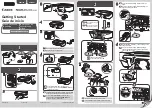
Installing MarkVision Professional
24
FindJava
This script is used by multiple scripts to locate the appropriate version of Java Virtual Machine on the
system. This script attempts to find the path to the “java” binary in standard system locations. If the
JVM is not found in standard system locations, it tries to search the
PATH
environment variable for
the JVM. If the search for the appropriate JVM fails, it exits with an error message informing the user
that a suitable JVM was not found. It also indicates the appropriate JVM version(s) required to run
the MarkVision Server software.
If you believe a suitable JVM is on the system, make sure it is in your PATH and run the /usr/mv_pro/
bin/findJava script again. This creates a symbolic link from /usr/mvp_java to the Java home directory
(JAVAHOME).
For example, if the full path to the appropriate “java” binary is:
/usr/local/java/bin/java
The Java home directory is “/usr/local/java.”
Therefore, the link can be created as follows:
# /bin/ln -s /usr/local/java /usr/mvp_java
MvService
The /usr/mv_pro/bin/MvService command is used to start and stop the MarkVision Professional
Server as a UNIX daemon.
$ man MvService
MvWebService
The /usr/mv_pro/bin/MvWebService command is used to start and stop the MarkVision Web Server.
The MvWebService process is used to provide the following services over HTTP:
•
Serve the MarkVision Professional Web Client
•
Provide access to MarkVision Messenger
•
Provide browser-based access to MarkVision Professional documentation
To access the above features, point your browser to port 9180 of the machine where you installed
MarkVision Professional Server with the following URL:
http://<markvision-server-host>:9180/markvision
or
http://<markvision-server-host>:9180/messenger
To uninstall the MarkVision Professional UNIX Client
1
Run the uninstall script which removes the symbolic links to the mounted directory from /usr/
mvp.
./MVJclient.unlink
















































